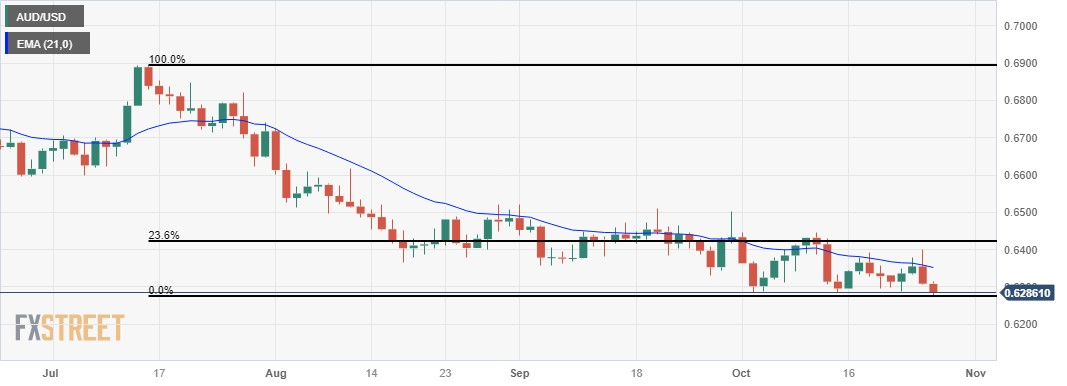- Australian Dollar loses ground as the US Dollar surges on risk aversion.
- Australia's currency could limit losses as RBA is expected to increase interest rates.
- US Dollar received upward support from improved US Treasury yields.
- Israel PM Netanyahu announced the readiness for a ground assault in Gaza.
The Australian Dollar (AUD) extends losses for the second session, trading around yearly lows against the US Dollar (USD) on Thursday. The AUD/USD pair faces a challenge on the upbeat Greenback, which could be attributed to the improved US Treasury yields.
Australia's inflation data introduced the prospect of a 25 basis points rate hike by the Reserve Bank of Australia (RBA) during its November meeting. The Australian Bureau of Statistics (ABS) unveiled on Wednesday that the Consumer Price Index (CPI) experienced an upswing in the third quarter of 2023.
RBA Governor Michele Bullock shared on Thursday that the CPI had a slight uptick, a tad beyond predictions, yet comfortably in the anticipated range. Bullock emphasized the central bank's balancing act—aiming to ease the economy's pace without stumbling into the recession's embrace.
The US Dollar Index (DXY) continues the winning streak on the back of the upbeat US Treasury yields, coupled with the more robust preliminary S&P Global PMI figures from the United States released on Tuesday.
Moreover, geopolitical uncertainties are poised to sustain the influx of safe-haven investments. Israel Prime Minister Benjamin Netanyahu announced the readiness for a ground assault in Gaza, with the timing of the invasion to be determined through consensus. Moreover, Iran's Foreign Minister Hossein Amir-Abdollahian has reached the USA for talks on the situation between Hamas and Israel, according to Iranian media.
Daily Digest Market Movers: Australian Dollar loses ground despite the possibility of another rate hike by the RBA
- Australia’s Consumer Price Index (CPI) reached 1.2% in the third quarter of 2023, surpassing the 0.8% uptick in the previous quarter and the market consensus of 1.1% in the same period.
- Australia's S&P Global Composite PMI in October slipped to 47.3 from the prior reading of 51.5. The Manufacturing PMI experienced a slight easing to 48.0 compared to the previous figure of 48.7, and the Services PMI regressed into contraction territory, dropping to 47.6 from the previous month's reading of 51.8.
- Australia's RBA expressed heightened concern about the inflation impact stemming from supply shocks. Governor of the Reserve Bank of Australia, Michele Bullock stated that if inflation persists above projections, the RBA will take responsive policy measures. There is an observable deceleration in demand, and per capita consumption is on the decline.
- China is gearing up to host a pivotal financial policy meeting early next week, occurring once every five years. The overarching goals of this gathering include the proactive tackling and mitigation of risks and the formulation of medium-term priorities for the extensive $61 trillion financial industry.
- US Treasury Department officially confirmed on Tuesday that the first meeting of the economic working group between the United States and China took place. This working group serves as a platform for discussing bilateral economic policy matters.
- US S&P Global Composite PMI reported an increase in October, reaching 51.0 from 50.2. The Services PMI experienced growth, reaching 50.9, while the Manufacturing PMI rose to 50.0.
- Investors will likely focus on the US Q3 Gross Domestic Product (GDP) on Thursday. The US Core Personal Consumption Expenditures (PCE) and Australia’s Producer Price Index (PPI) will be eyed on Friday.
Technical Analysis: Australian Dollar hovers around major resistance at 0.6300
The Australian Dollar trades around 0.6300 major resistance on Thursday, pulling back from the yearly low at 0.6270 followed by the key support around the 0.6250 major level. On the upside, the 0.6300 major level emerges as the immediate resistance. A breakthrough above this resistance can reach around the 21-day Exponential Moving Average (EMA) at 0.6352 following the 23.6% Fibonacci retracement level at 0.6421.
AUD/USD: Daily Chart
Australian Dollar price today
The table below shows the percentage change of Australian Dollar (AUD) against listed major currencies today. Australian Dollar was the weakest against the New Zealand Dollar.
| USD | EUR | GBP | CAD | AUD | JPY | NZD | CHF | |
| USD | 0.20% | 0.12% | 0.00% | -0.12% | 0.30% | -0.09% | 0.16% | |
| EUR | -0.19% | -0.07% | -0.19% | -0.33% | 0.10% | -0.28% | -0.02% | |
| GBP | -0.12% | 0.08% | -0.10% | -0.25% | 0.19% | -0.22% | 0.06% | |
| CAD | 0.00% | 0.18% | 0.10% | -0.15% | 0.30% | -0.11% | 0.16% | |
| AUD | 0.14% | 0.33% | 0.26% | 0.14% | 0.44% | 0.03% | 0.32% | |
| JPY | -0.30% | -0.08% | -0.17% | -0.28% | -0.45% | -0.40% | -0.12% | |
| NZD | 0.09% | 0.28% | 0.22% | 0.11% | -0.03% | 0.41% | 0.28% | |
| CHF | -0.18% | 0.02% | -0.06% | -0.16% | -0.32% | 0.14% | -0.28% |
The heat map shows percentage changes of major currencies against each other. The base currency is picked from the left column, while the quote currency is picked from the top row. For example, if you pick the Euro from the left column and move along the horizontal line to the Japanese Yen, the percentage change displayed in the box will represent EUR (base)/JPY (quote).
RBA FAQs
What is the Reserve Bank of Australia and how does it influence the Australian Dollar?
The Reserve Bank of Australia (RBA) sets interest rates and manages monetary policy for Australia. Decisions are made by a board of governors at 11 meetings a year and ad hoc emergency meetings as required. The RBA’s primary mandate is to maintain price stability, which means an inflation rate of 2-3%, but also “..to contribute to the stability of the currency, full employment, and the economic prosperity and welfare of the Australian people.” Its main tool for achieving this is by raising or lowering interest rates. Relatively high interest rates will strengthen the Australian Dollar (AUD) and vice versa. Other RBA tools include quantitative easing and tightening.
How does inflation data impact the value of the Australian Dollar?
While inflation had always traditionally been thought of as a negative factor for currencies since it lowers the value of money in general, the opposite has actually been the case in modern times with the relaxation of cross-border capital controls. Moderately higher inflation now tends to lead central banks to put up their interest rates, which in turn has the effect of attracting more capital inflows from global investors seeking a lucrative place to keep their money. This increases demand for the local currency, which in the case of Australia is the Aussie Dollar.
How does economic data influence the value of the Australian Dollar?
Macroeconomic data gauges the health of an economy and can have an impact on the value of its currency. Investors prefer to invest their capital in economies that are safe and growing rather than precarious and shrinking. Greater capital inflows increase the aggregate demand and value of the domestic currency. Classic indicators, such as GDP, Manufacturing and Services PMIs, employment, and consumer sentiment surveys can influence AUD. A strong economy may encourage the Reserve Bank of Australia to put up interest rates, also supporting AUD.
What is Quantitative Easing (QE) and how does it affect the Australian Dollar?
Quantitative Easing (QE) is a tool used in extreme situations when lowering interest rates is not enough to restore the flow of credit in the economy. QE is the process by which the Reserve Bank of Australia (RBA) prints Australian Dollars (AUD) for the purpose of buying assets – usually government or corporate bonds – from financial institutions, thereby providing them with much-needed liquidity. QE usually results in a weaker AUD.
What is Quantitative tightening (QT) and how does it affect the Australian Dollar?
Quantitative tightening (QT) is the reverse of QE. It is undertaken after QE when an economic recovery is underway and inflation starts rising. Whilst in QE the Reserve Bank of Australia (RBA) purchases government and corporate bonds from financial institutions to provide them with liquidity, in QT the RBA stops buying more assets, and stops reinvesting the principal maturing on the bonds it already holds. It would be positive (or bullish) for the Australian Dollar.
Information on these pages contains forward-looking statements that involve risks and uncertainties. Markets and instruments profiled on this page are for informational purposes only and should not in any way come across as a recommendation to buy or sell in these assets. You should do your own thorough research before making any investment decisions. FXStreet does not in any way guarantee that this information is free from mistakes, errors, or material misstatements. It also does not guarantee that this information is of a timely nature. Investing in Open Markets involves a great deal of risk, including the loss of all or a portion of your investment, as well as emotional distress. All risks, losses and costs associated with investing, including total loss of principal, are your responsibility. The views and opinions expressed in this article are those of the authors and do not necessarily reflect the official policy or position of FXStreet nor its advertisers. The author will not be held responsible for information that is found at the end of links posted on this page.
If not otherwise explicitly mentioned in the body of the article, at the time of writing, the author has no position in any stock mentioned in this article and no business relationship with any company mentioned. The author has not received compensation for writing this article, other than from FXStreet.
FXStreet and the author do not provide personalized recommendations. The author makes no representations as to the accuracy, completeness, or suitability of this information. FXStreet and the author will not be liable for any errors, omissions or any losses, injuries or damages arising from this information and its display or use. Errors and omissions excepted.
The author and FXStreet are not registered investment advisors and nothing in this article is intended to be investment advice.
Recommended content
Editors’ Picks

Gold falls amid a possible de-escalation of US-China tensions Premium
Gold pulled back from its all-time high of $3,500 per troy ounce reached earlier on Tuesday, as a resurgent US Dollar and signs of easing tensions in the US–China trade dispute appeared to draw sellers back into the market.

EUR/USD retreats to daily lows near 1.1440
EUR/USD loses the grip and retreats to the 1.1440 zone as the Greenback’s rebound now gathers extra steam, particulalry after some positive headlines pointing to mitigating trade concerns on the US-China front on Tuesday.

GBP/USD deflates to weekly lows near 1.3350
GBP/USD loses further momentum and recedes to the 1.3350 zone on Tuesday, or two-day troughs, all in response to the frmer tone in the US Dollar and encouraging news from the US-China trade scenario.

3% of Bitcoin supply in control of firms with BTC on balance sheets: The good, bad and ugly
Bitcoin disappointed traders with lackluster performance in 2025, hitting the $100,000 milestone and consolidating under the milestone thereafter. Bitcoin rallied past $88,000 early on Monday, the dominant token eyes the $90,000 level.

Five fundamentals for the week: Traders confront the trade war, important surveys, key Fed speech Premium
Will the US strike a trade deal with Japan? That would be positive progress. However, recent developments are not that positive, and there's only one certainty: headlines will dominate markets. Fresh US economic data is also of interest.

The Best brokers to trade EUR/USD
SPONSORED Discover the top brokers for trading EUR/USD in 2025. Our list features brokers with competitive spreads, fast execution, and powerful platforms. Whether you're a beginner or an expert, find the right partner to navigate the dynamic Forex market.




